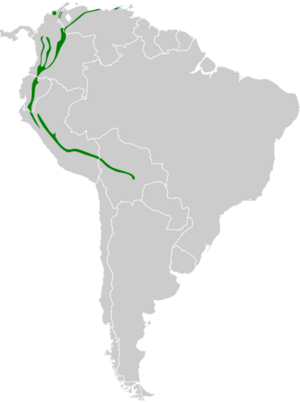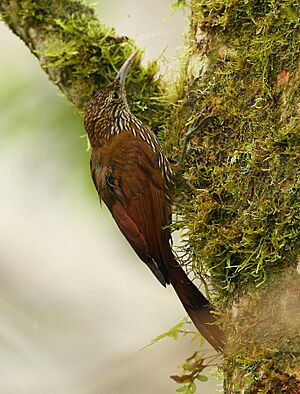Montane woodcreeper facts for kids
Quick facts for kids Montane woodcreeper |
|
|---|---|
 |
|
| Lepidocolaptes lacrymiger sneiderni, Colombia | |
| Conservation status | |
| Scientific classification | |
| Genus: |
Lepidocolaptes
|
| Species: |
lacrymiger
|
 |
|
The Montane Woodcreeper (scientific name: Lepidocolaptes lacrymiger) is a type of perching bird. It belongs to the ovenbird family, which is known for building unique nests. You can find this bird in several South American countries, including Bolivia, Colombia, Ecuador, Peru, and Venezuela.
Contents
What is a Montane Woodcreeper?
This bird was once thought to be the same species as the Spot-crowned Woodcreeper. However, in the early 2000s, scientists decided they were different species. This means they are now recognized as distinct birds.
Different Types of Montane Woodcreepers
There are nine different kinds, or subspecies, of the Montane Woodcreeper. Each subspecies has slight differences in appearance or where they live. They are:
- Lepidocolaptes lacrymiger sanctaemartae
- Lepidocolaptes lacrymiger sneiderni
- Lepidocolaptes lacrymiger lacrymiger
- Lepidocolaptes lacrymiger lafresnayi
- Lepidocolaptes lacrymiger aequatorialis
- Lepidocolaptes lacrymiger frigidus
- Lepidocolaptes lacrymiger warscewiczi
- Lepidocolaptes lacrymiger carabayae
- Lepidocolaptes lacrymiger bolivianus
How to Identify a Montane Woodcreeper
The Montane Woodcreeper is a small to medium-sized bird. It is about 19 to 19.5 centimeters (about 7.5 inches) long. Males usually weigh a bit more than females.
What Does it Look Like?
Both male and female Montane Woodcreepers look similar. They have a slim bill that curves slightly downwards. Their face and neck have many streaks. They often have a broken whitish stripe above their eye, called a supercilium.
Their head and the back of their neck are dusky brown. They have clear whitish-buff spots with black tips. These spots turn into streaks on the back of their neck. Their back and wing feathers are rufous-brown, which is a reddish-brown color. Their rump, wings, and tail are a rufous-chestnut color.
The underside of their body is olive-brown. It has long, wide, buffy streaks that are edged and tipped with black. Their eyes are dark brown. Their legs and feet are olive-gray to dark horn in color. The upper part of their beak is dark, while the lower part is pale gray to whitish.
Young Woodcreepers
Young Montane Woodcreepers have streaks on their underside that are not as clear. Their bill is also shorter and darker than adult birds.
Subspecies Differences
The different subspecies have small variations in their colors and markings. For example, some might have a paler throat or grayer underparts. Others might be darker or have more reddish-brown tones. The streaks on their bodies can also vary in size and color.
Where Montane Woodcreepers Live
The Montane Woodcreeper lives in different parts of South America. Each subspecies is found in specific areas.
Specific Locations
- L. l. sanctaemartae lives in the Santa Marta region of northern Colombia.
- L. l. sneiderni is found in Colombia's Western and Central Andes mountains. It also lives on the western slope of the Eastern Andes.
- L. l. lacrymiger lives on the eastern slope of Colombia's Eastern Andes and in western Venezuela.
- L. l. lafresnayi is found in the Venezuelan Coastal Range.
- L. l. aequatorialis lives on the western slope of the Andes in southwestern Colombia and both slopes in Ecuador.
- L. l. frigidus is found on the eastern slope of the Andes in Colombia's Nariño Department.
- L. l. warscewiczi lives on the eastern slope of the Andes in southeastern Ecuador and into Peru.
- L. l. carabayae is found on the eastern slope of the Andes in southeastern Peru.
- L. l. bolivianus lives on the eastern slope of the Andes in northwestern and central Bolivia.
Preferred Homes
Montane Woodcreepers live in many types of forests. They prefer forests at middle to high elevations. They especially like montane evergreen forests and cloudforests. They can also be found in open woodlands and forests where trees are shorter near the treeline.
They live inside dense, untouched forests. However, they are more common at the edges of these forests. They also live in forests that have regrown after being cut down. Sometimes, they are seen in clearings or pastures that have trees.
They usually live at elevations between 1,750 and 3,000 meters (about 5,700 to 9,800 feet). Sometimes, they are found as low as 900 meters (about 3,000 feet) in Venezuela. In Colombia, they live between 1,700 and 3,500 meters (about 5,600 to 11,500 feet). In Ecuador, they are found between 1,500 and 3,000 meters (about 4,900 to 9,800 feet).
Montane Woodcreeper Behavior
Movement and Travel
Most Montane Woodcreepers stay in the same area all year round. However, in Venezuela, some birds might move to lower elevations during the rainy season.
What They Eat and How They Hunt
The exact diet of the Montane Woodcreeper is not fully known. But they mainly eat arthropods, which are creatures like insects and spiders. They usually look for food alone or in pairs.
They often join groups of different bird species that are feeding together. They are not known to follow swarms of army ants, which many other birds do to find food.
These birds climb up tree trunks and along the underside of branches. They usually search for food in the middle to upper parts of the forest. They rarely go near the ground. They catch their prey by picking it off surfaces. They also probe into cracks in bark, epiphytes (plants that grow on other plants), and moss.
Reproduction and Family Life
The breeding seasons for Montane Woodcreepers vary depending on the location. Generally, they lay eggs between April and August. They make their nests in holes in trees or stumps. These holes can be natural or made by woodpeckers.
One nest was found to have three eggs. We don't know how long the eggs take to hatch or how long it takes for the young birds to leave the nest. It is believed that pairs stay together all year. Both parents are thought to help care for their young.
Their Calls and Songs
The Montane Woodcreeper does not sing very often. Its song is a series of 10 to 15 high-pitched whistles. The song lasts about 2.5 seconds. It starts slowly and then speeds up, going lower in pitch. It sounds like "tsip, tsip, tsip, ts-ts-tseeeéu, tseeu, tseu-tseu-tseu-tseu" or "tseu, tseu, tsip-tsip, tsee-tsee-tsee-tsee-tsee." They also make a "series of 3 reedy squeaks," a "double-noted cry," and a "rattle with introductory 'ah'."
Conservation Status
The IUCN (International Union for Conservation of Nature) has evaluated the Montane Woodcreeper. They have classified it as a species of "Least Concern." This means that the bird is not currently in danger of disappearing.
Why It's Not Endangered
The Montane Woodcreeper lives across a very large area. Even though we don't know the exact number of birds, their population is believed to be stable. There are no immediate threats that scientists have identified.
It is considered uncommon to fairly common in most places. In some areas, it is even common. However, it is rare in the dry forests of northern Bolivia. This bird can live in forests that have regrown or at the edges of forests. This suggests that human activities do not affect it too much.



